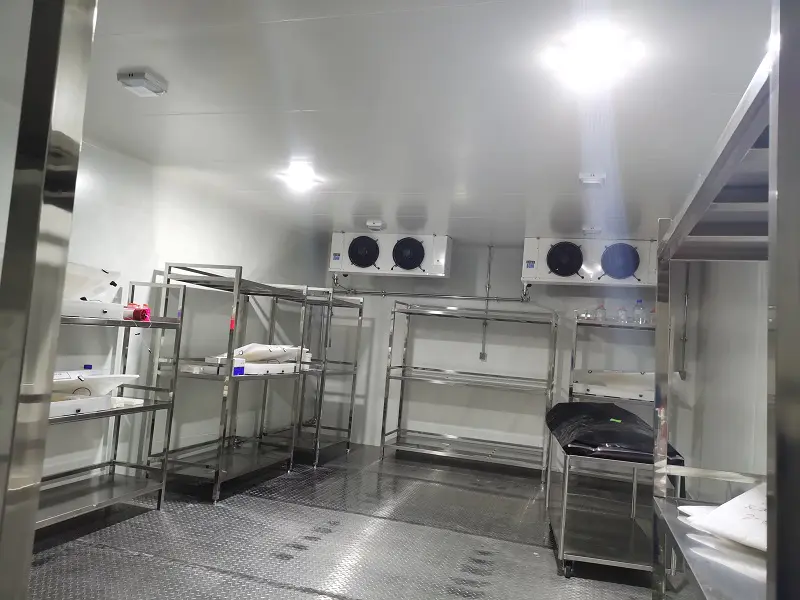Wondering how much a restaurant cold room costs or how much food it can hold? Here’s a complete guide to help you design a cost-effective, energy-efficient kitchen cold room for your restaurant or hotel.
As the restaurant and catering industry continues to grow rapidly, proper food storage has become one of the most important aspects of food safety management. For hotels, restaurants, and catering kitchens, building a cold room (walk-in cooler or freezer) ensures freshness, prevents spoilage, and maintains food quality.
So, what should you pay attention to when planning and installing a restaurant kitchen cold room? Let’s look at some key points — plus what kind of investment and storage capacity you can expect.

Real shot of the restaurant kitchen cold storage room
1. Cold Room Temperature Design
Restaurant kitchen cold rooms are typically divided based on the types of food stored:
- Vegetables & Fruits Storage: +0°C to +5°C
- Meat & Seafood Freezer: –10°C to –18°C
- Cold Dish Preparation Room: +16°C
- Cutting/Processing Area: around +12°C
A professional cold room contractor will design multiple temperature zones if your kitchen handles both fresh and frozen items. This ensures each product stays at its ideal preservation temperature, maximizing food quality and shelf life.
2. Cold Room Storage Capacity & Layout
Before construction begins, it’s important to plan your storage volume and internal layout carefully.
For example:
- A 30㎡ cold room can store roughly 10–15 tons of mixed food ingredients.
- A 100㎡ cold room can hold up to 40–55 tons, suitable for medium-sized restaurants or hotels.
Proper racking systems and aisle spacing should be included to make it easy for staff to move goods, clean the area, and perform maintenance safely. This helps maintain smooth operation and hygienic standards in busy kitchen environments.
3. Installation Site Requirements
The restaurant cold room should be installed close to the kitchen or delivery area, making it convenient for daily use.
When selecting a site, ensure that it is:
- Dry and well-ventilated (avoid moisture accumulation or water pooling)
- Structurally level (to support equipment and insulation panels)
- Easy to access for cleaning and maintenance
Even small restaurants can install modular cold rooms with PU sandwich insulation panels, which don’t require complex civil construction — saving both space and time.

Real shot of the restaurant kitchen cold storage room
4. Investment & Operating Cost Overview
The cost of a restaurant kitchen cold room depends on size, temperature requirements, and equipment configuration:
- Chiller Room (+0~+5°C): approx. $300–$400 per m²
- Freezer Room (–18°C): approx. $600–$900 per m²
So, for reference:
- A 30㎡ walk-in cold room may cost around $9,000–$11,500
- A 100㎡ combined chiller & freezer room may cost about $55,000–$65,000
With proper insulation and high-efficiency compressors, monthly power consumption can be reduced by 20–30%, providing long-term savings for restaurant owners.
5. Key Benefits for Restaurant Owners
By installing a professional-grade cold room, restaurants can:
- Extend food shelf life and reduce daily waste
- Meet food safety and hygiene standards (HACCP-compliant design)
- Save energy through efficient compressor systems and insulation materials
- Improve kitchen workflow and inventory management
With a one-time investment, you gain a reliable food preservation system that supports daily operations, minimizes waste, and ensures consistent food quality — all crucial for successful restaurant management.
For real examples of how we helped restaurants build efficient cold storage systems, check out our restaurant cold room project cases
 China cold storage solution provider
China cold storage solution provider
